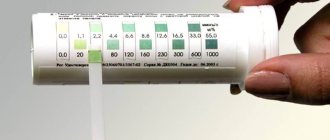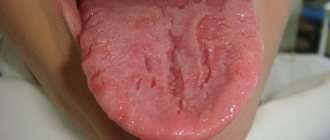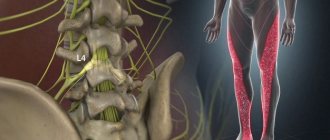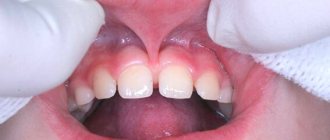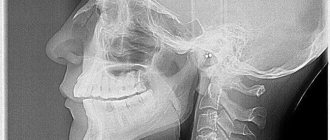Doctors Cost
Price list Doctors clinic
The feeling of numbness in the limbs is called paresthesia in medicine (from the Greek words “πᾰρά” - “outside, around, past” and “aisthesis” - “sensation”). This is the loss of normal tissue sensitivity due to impaired transmission of nerve impulses. It seems to a person that he is being touched through a layer of cotton wool.
Occurs at any age, often accompanied by tingling and goosebumps. It may be a physiological condition associated with prolonged compression of a nerve or blood vessels while in an uncomfortable position. When changing position, sensitivity is quickly restored. If the sensation is repeated, is not associated with an uncomfortable position, and lasts a long time, it requires diagnosis, as it may be a symptom of a dangerous disease.
Reasons for development
Various factors lead to impaired sensitivity, which can be divided into several large groups.
Table 1. Numbness of the extremities of the arms and legs: causes
| Cause | Examples of diseases, conditions |
| Squeezing blood vessels and nerve endings. | Intervertebral hernia, osteochondrosis, spondylosis, neoplasms. |
| Narrowing, blockage, deformation of veins. | Thrombophlebitis, varicose veins. |
| Cardiovascular diseases. | Cardiac ischemia. |
| Pathology of the nervous system. | Polyneuropathy, neuritis, radiculoneuritis, stroke. |
| Damage to blood vessels and nerves. | Injuries, postoperative complications. |
All paresthesias are fundamentally divided into two types.
- Transient. Caused by temporary compression of the neurovascular bundle – ischemia.
- Permanent. Occurs when there is anatomical damage to blood vessels or nerves.
If a person periodically experiences transient numbness, you should consult a neurologist for a thorough examination. This will help prevent life-threatening diseases: stroke, heart attack.
If an unpleasant sensation occurs and does not go away, you should also consult a doctor. Such problems do not disappear on their own. Without treatment, they can lead to disability.
Why does paresthesia occur?
Decreased sensitivity in various parts of the body is called paresthesia. In dentistry, this pathological condition is associated with nerve damage.
Numbness after tooth extraction most often occurs if a wisdom tooth has been removed. This is due to the fact that the roots of the “eights” are located close to the nerve, which can be damaged due to:
- Traumatic tooth extraction (with its abnormal structure).
- Compression due to postoperative tissue swelling.
- Inaccurate actions of the dentist when administering an anesthetic.
Paresthesia most often occurs in patients over 25 years of age. Other factors that increase the risk of developing pathology include:
- history of neuralgia;
- cardiovascular pathologies;
- diseases of the endocrine system (including diabetes mellitus);
- lack of vitamins and minerals in the body;
- weak immunity.
Signs and symptoms
Complications after tooth extraction are indicated by long-term symptoms that persist for a week or more:
- Lack of sensitivity in a certain area of the face.
- Numbness of the tongue.
- Burning and tingling.
- Weakness of the jaw, inability to close the teeth completely.
- Partial or complete loss of taste.
- Increased salivation.
Constant numbness in the extremities of the body
Carpal tunnel syndrome
The nerve fiber, located in a tight space limited by muscles and bones, is compressed by swollen tissues. Carpal tunnel syndrome is a common problem for modern people in certain professions: programmers, guitarists, artists, drummers - everyone whose work involves prolonged, monotonous stress on the hands. It manifests itself as paresthesia of the hand, pain, burning, sensation of electric shock, weakness, and inability to make some movements.
Radiculopathy
Compression of a nerve root by an intervertebral hernia. Numbness of an arm or leg depends on the level of compression and is accompanied by pain, muscle weakness, and impaired reflexes. At first it manifests itself as mild numbness of the extremities, gradually the symptoms increase. The pain decreases when lying down, but increases when the person stands, coughs or sneezes.
Metabolic polyneuropathy
It is characterized by a symmetrical lesion that develops due to a disturbance in metabolic processes in nerve fibers. It can be caused by diabetes mellitus, alcoholism, chronic renal failure, deficiency of vitamin B1, B12. Manifested by paresthesia, loss of sensation in the lower extremities, weakness, paresis.
Multiple sclerosis
Associated with the destruction of the myelin sheath (demyelination) of nerve fibers, which disrupts the conduction of nerve impulses. First, a transient sensation of numbness in the arms or legs appears, crawling along the fingertips, then the symptoms become more pronounced and permanent.
Polymyalgia rheumatica
Develops in people over 50 years of age. Accompanied by severe pain in symmetrical muscles, aggravated by movement, persisting at night. Most patients complain of muscle stiffness, numbness of the limbs in the morning and after prolonged immobility.
Factors of occupational hazard
Paresthesia is often caused by vibration and ultrasound. They damage peripheral nerves, cause loss of tactile sensitivity, numbness of the fingers, and intolerance to cold.
Symptoms
Numbness usually occurs due to poor circulation in a particular area or nerve damage. Sensory disturbances (numbness) can also be the result of infection, inflammation, trauma and other pathological processes. In most cases, numbness is due to non-life-threatening illnesses, but it can also be a sign of a stroke or tumor.
Numbness in the extremities is often associated with pain or may be accompanied by other sensory disturbances such as burning or tingling. Strokes also cause motor and speech disorders. Depending on the cause, numbness may disappear quickly, for example, numbness in the arm , which occurs when a person sleeps with their head on their arm, disappears after a few movements of the arm. Chronic numbness in a leg or arm over a long period of time usually indicates some level of nerve damage, such as due to diabetes or multiple sclerosis. Chronic numbness in the fingers may be due to a pinched nerve, as is the case with carpal tunnel syndrome. In any case, numbness that lasts more than a few minutes merits attention and medical attention. And if a person experiences numbness in the groin area and impaired bladder and bowel function, or there are signs of paralysis, confusion, speech impairment, then in such cases it is necessary to seek emergency medical help.
Symptoms that may accompany numbness:
- Anxiety
- Burning feeling
- Frequent urination
- Increased numbness or tingling while walking
- Itching
- Lower back pain
- Muscle spasms
- Pain in the neck
- Pain in other parts of the body
- Pins and needles sensation
- Rash
- Increased sensitivity to touch
A number of symptoms accompanying numbness may be a sign of serious conditions and this must be taken into account by the doctor, since emergency medical care and necessary medical procedures are often required.
These are the following symptoms:
- Lethargy or momentary loss of consciousness
- Labored breathing
- Difficulty walking
- Dizziness
- Loss of control over voluntary urination or bowel movements
- Visual impairment
- Numbness in the head, neck, back
- Paralysis
- Speech disorders (dysarthria)
- Weakness
Diagnostics
Clinical symptoms are of great importance for making a diagnosis. Therefore, the doctor carefully asks the patient about when the disease began, how it manifests itself, and what helps.
Table 2. Differential diagnosis of numbness and tingling in the extremities. Possible reasons
| Affected limbs | Localization, features of numbness | Presumable disease |
| Upper | Sudden lesion of one arm. | Intervertebral disc herniation, spondylosis, osteochondrosis, plexitis, tunnel syndrome |
| Combined with impaired active movements. | Polyneuropathy, plexitis, tunnel syndrome. | |
| Symmetry. | Intoxication, infection. | |
| Blueness of fingers. | Raynaud's disease. | |
| Affects all fingers except the little finger | Carpal tunnel syndrome. | |
| Paresthesia of the little finger | Ulnar nerve neuritis, ischemic heart disease | |
| Lower | The pathological process affects the legs and lower back. | Osteochondrosis, lumbar hernia, atherosclerosis, pinched sciatic nerve, cauda equina syndrome. |
| Combined with impaired active movements. | Arthritis, multiple sclerosis, carpal tunnel syndrome, polyneuropathy, stroke. | |
| Damage to the lower leg and foot in combination with pain and muscle tension. | Thrombophlebitis, neuropathy, varicose veins. | |
| Paresthesia of the toes. | Arthritis of the thumb, radiculoneuritis, neoplasm, polyneuropathy. | |
| Top and bottom | Numbness of the left or right limbs | There may be several reasons: stroke, brain tumor, multiple sclerosis, transient ischemic attack. |
3. Symptoms and diagnosis
Actually, paresthetic sensations are described quite fully at the beginning of the article. In a generalized form, paresthesia can include any sensation in the skin (or under the skin) in which there is no directly observable stimulus in this area. As a rule, paresthesia does not include pain, which is also often accompanied by lesions of the nerve pathways (for example, with herpes zoster).
Paresthesia is diagnosed based on a careful study of the history and sensations verbalized by the patient during a clinical interview and examination (sometimes the condition of the skin in the disturbing area is significant). Skin sensitivity as such must be examined: areas of slightly or insensitive skin are often found. To clarify the nature and localization of the causes of paresthesia, electroneuromyography may be prescribed, as well as, if indicated, tomographic studies of the brain and/or spinal cord; toxicological, virological, biochemical laboratory tests, etc.
About our clinic Chistye Prudy metro station Medintercom page!
Treatment
Table 3. Numbness of the extremities: causes and symptoms, treatment
| Cause | Symptoms, examples of pathologies | Treatment |
| Circulatory disorders | Ischemia, arterial hypertension, thromboembolism. | Treatment of the underlying disease. |
| Orthopedic problems | Disc herniation, osteochondrosis. | Conservative or surgical therapy to eliminate compression of the nerve roots. |
| Nerve compression | Tunnel syndrome, polyneuropathy. | Elimination of tissue edema, restoration of metabolic processes. |
DIAGNOSIS AND TREATMENT OF NUMBITY
It is very important for the doctor to know what symptoms accompany the loss of sensitivity, what diseases are present, what is the duration, when it intensifies, whether it was preceded by injury or excessive physical activity, and whether there is back pain. All this information allows the doctor to make a preliminary diagnosis. To confirm it, additional diagnostic measures are prescribed. Treatment for numbness will consist of eliminating the identified cause, for example, straightening pinched nerve roots.
Causes of paresthesia
We found out what paresthesia of the body is. Why does it occur? The mechanism is simple: a failure in the transmission of nerve impulses occurs in the nerve root and irritation occurs. Most often this is observed when there is pressure on the nerve ending. Compressive factors can be:
- benign and malignant tumors;
- osteocondritis of the spine;
- a tourniquet that is placed around a limb to stop bleeding.
Also, paresthesia often occurs with the following diseases and conditions:
- nerve ending injuries;
- exposure to high temperatures (for this reason, paresthesia of the lips and tongue may occur);
- inflammatory processes on the part of the vessels that supply blood to the nerve roots;
- endocrinological disorders (diabetes mellitus);
- poisoning by biological toxins or industrial poisons;
- lack of B vitamins.
The causes of paresthesia of the fingers are generally the same as the causes of a similar disorder in the feet, head or torso. The larger the nerve root that is affected, the larger the area of paresthesia.
Diagnosis of the disease
To determine the disease, the doctor conducts a visual examination, studies the patient’s history and complaints. For example, the condition of the skin, its color and temperature are checked. Laboratory diagnostic procedures are also carried out:
- blood analysis;
- toxicological analysis;
- MRI of the spine, head;
- Ultrasound of cervical vessels;
- X-ray of legs;
- diagnosis of the thyroid gland.
This symptom can occur as part of damage to the nervous and cardiovascular systems of various etiologies. Among the most well-known causes of numbness in the hands are osteochondrosis of the cervical spine, tunnel syndromes, Raynaud's syndrome, neuritis, diabetic, toxic and other neuropathies, neurocirculatory dystonia, as well as more rare conditions - multiple sclerosis, atherosclerosis of the vessels of the upper extremities, brain tumors and others diseases. In some cases, numbness and other unpleasant sensations can lead to a significant decrease in the quality of life, in others it can lead to complications such as necrotic changes in tissue (for example, in atherosclerosis), the addition of other symptoms in tumors of the nervous system - serve as a poor prognostic sign.
Osteochondrosis of the cervical spine is a chronic degenerative disease that affects the intervertebral discs with their gradual destruction (formation of prolapse, hernial protrusions) and the appearance of a clinical picture of compression, stretching of the spinal roots, spinal cord, as well as reflex irritation of the muscles and ligaments. Numbness in this case is usually observed only on one side (can be provoked by an incorrect position during sleep), as well as other symptoms: headaches, neck muscle tension, radicular pain syndrome. The main diagnostic methods include visualization methods of the cervical spine - radiography, CT and MRI, which make it possible to identify characteristic changes (instability of the affected segment, decreased height of the intervertebral disc, hernias, damage to ligaments and muscles). Treatment is usually symptomatic and includes physical activity, exercise therapy, manual therapy, physiotherapy, painkillers and muscle relaxants during exacerbations; in severe cases, surgical treatment methods are used.
One of the most common tunnel syndromes is compression of the median nerve (carpal tunnel syndrome). The reasons for the development of this neuropathy include factors that lead to a narrowing of the carpal tunnel, in which the median nerve passes. Numbness and unpleasant sensations in the form of tingling and burning are localized in this case in the area of the thumb and index finger on the palm side. The main diagnostic methods include clinical (Tinel test) and electroneuromyography. Treatment can be conservative (using glucocorticosteroids, wearing an orthosis) or surgical - excision of the ligament limiting the canal.
Raynaud's syndrome is a condition that occurs as a result of dysregulation of vascular tone and is accompanied by spastic reactions of the small vessels of the hand in response to physical or emotional influence. The clinical picture is represented by attacks of vascular spasm in the area of 1-4 fingers with a characteristic change in the color of the skin (pallor, blueness and redness) with a feeling of numbness and burning. There is both primary Raynaud's syndrome and secondary - against the background of other diseases (scleroderma, SLE, dermatomyositis). Diagnosis is usually based on the characteristic clinical picture. For treatment, drugs are used - calcium antagonists, inhibitors of specific enzymes, prostaglandin analogues, vasodilators.
Late-stage diabetes mellitus can damage nerve fibers, leading to the development of both distal (lower limb) and proximal (upper limb) neuropathy. At the same time, sensitivity decreases, burning sensations, numbness and pain appear, especially at night, and in the future, damage to the motor nerves may occur with a decrease in strength in the limbs and deformation. Diagnosis in the later stages of the disease is usually not difficult and the diagnosis is usually already known to patients. In other cases, to make a diagnosis it is necessary to determine the glucose level, determine the function of internal organs that may be affected by diabetes (kidneys, retina, cardiovascular system), and also conduct electroneuromyography to confirm nerve damage and its severity.
Atherosclerosis of the vessels of the upper extremities at the first stage is manifested by cramps, numbness, burning and coldness of the extremities against the background of exercise, however, as the disease progresses (an increase in the atherosclerotic plaque and an increasing restriction of blood flow through the affected vessel), the symptoms persist at rest, and later without appropriate treatment Necrosis and gangrene of the fingers may occur. In addition to clinical examination, diagnostics includes visualization of blood flow disorders (contrast angiography, ultrasound examination methods). Radical treatment is carried out only by surgical methods (plaque removal, vessel plastic surgery, bypass surgery).
To diagnose and treat numbness in the hands, at the first stage you need to consult a general practitioner, who will help identify additional symptoms and prescribe the necessary examination methods and consultation with other specialists.
Folk remedies
Photo: xcook.info
Folk remedies will not eliminate the cause of the development of paresthesia, but will help alleviate the symptoms and, thereby, improve the general condition of the person.
First of all, you should carefully monitor your lifestyle and diet. It is recommended to stop smoking and drinking alcohol, and not to abuse hot and spicy foods. Jerusalem artichoke has a good effect (helps eliminate numbness due to its beneficial effect on nerves and blood vessels).
Medicinal baths and contrast baths are also used. To prepare a medicinal bath, you can use herbs such as sage, chamomile, and string. The water temperature should not be hot, but comfortable for humans. Reception time is no more than 15 minutes. You can complement the effect with a massage with warming cream, which is performed immediately after taking a bath.
Contrast baths will help improve blood circulation and increase muscle tone. To carry out the procedure, you should prepare 2 basins with hot and cold water. The essence of the procedure is to alternately lower the feet into one and then into the other basin.
You can purchase a massage roller or brush for daily use. This kind of massage helps improve blood circulation and reduce the symptoms of paresthesia. But you should not massage areas of the body for too long and actively, so as not to injure the skin and cause irritation.
Soothing infusions of medicinal herbs have a good effect, since one of the reasons for the development of paresthesia is psycho-emotional stress. Herbs such as motherwort, mint, chamomile, adonis, and lemon balm are suitable for this. Decoctions are taken during the day in 3-4 doses. The course of herbal treatment lasts no more than 1 month, then a break is taken for several weeks, after which, if necessary, the course is repeated.
The information is for reference only and is not a guide to action. Do not self-medicate. At the first symptoms of the disease, consult a doctor.

